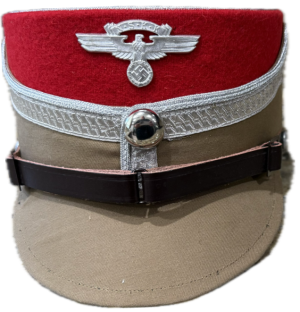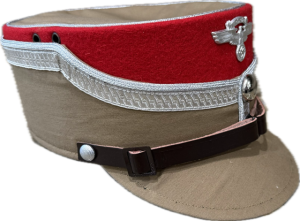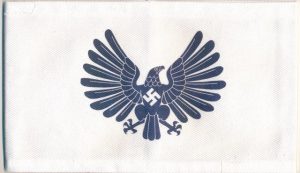Adolf Hühnlein Korpsführer NSKK WWII Kepi Germany
$70.00
1 in stock
Adolf Hühnlein (12 September 1881 – 18 June 1942) was a German soldier and Nazi Party (NSDAP) official. He was the Korpsführer (Corps Leader) of the National Socialist Motor Corps (NSKK) from 1933 until his death in 1942. Extremely rare even as a reproduction.
On 30 April 1933, Hühnlein was named Korpsführer of the NSKK. On 2 September 1934, some two months after Röhm’s death in the Night of the Long Knives, the NSKK was made an independent organization, free from SA oversight. It was a paramilitary organization with its own system of paramilitary ranks and the smallest of the Nazi Party paramilitary organizations. Under Hühnlein’s leadership, the NSKK membership rose rapidly, from 30,000 men in April 1933 to 350,000 in September 1933, after absorbing all of Germany’s private motor clubs. By 1939, there were 500,000 NSKK members.
The primary aim of the Corps was to educate its members in motoring skills and to transport NSDAP and SA officials/members.[6] Hühnlein organized and supervised many propaganda-oriented racing events, such as the 2000 kilometer “Race through Germany.” All race car drivers were required to become members of the NSKK. Hühnlein often presented the trophies at German Grand Prix races and made certain that Nazi flags and bunting covered the victory tribunes. The most famous race car driver that had to answer to Hühnlein was Bernd Rosemeyer, who drove the Auto Union Silver Arrow. From 1935 onward, the NSKK also provided training for panzer crews and drivers of the German Army.[8] Working with Hühnlein, Heinz Guderian, the architect of Germany’s panzer formations, was able to ensure the training of Germany’s future tank and truck drivers, approximately 187,000 of them in the years 1933 to 1939.
In June 1933, Hühnlein was named leader of the German Motor Transport Association. In September 1933, he founded the German Automobile Club and became the president of the National Sports Authority for German Motor Sports. In December 1935, Hühnlein was made a member of the Reich Transportation Council and in 1936 made a member of the Academy for German Law. On 19 May 1936, he was raised to the rank of a Generalmajor (retired), in the Wehrmacht, and in December of that year was named to the Board of Directors of the Reichsautobahn Association. In addition, on 8 September 1938 he was appointed as an NSDAP Reichsleiter, the second highest political rank in the Nazi Party. After the outbreak of the Second World War, he was named by Reichsmarschall Hermann Göring, in his capacity as the head of the Four Year Plan, to be the “Representative for Motorized Transport of the War Economy” on 22 February 1940.
Hühnlein remained the NSKK Korpsführer from 30 April 1933 until his death from cancer in Munich on 18 June 1942. He was honored with a state funeral on 21 June at which Joseph Goebbels provided the eulogy and Hitler laid a wreath on the coffin. He was posthumously awarded the Party’s highest decoration, the German Order, on 22 June 1942.
Related products
Armbands
















